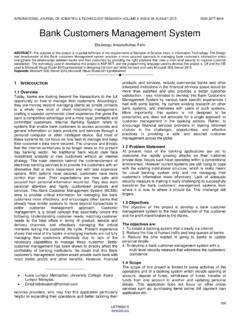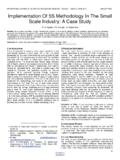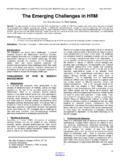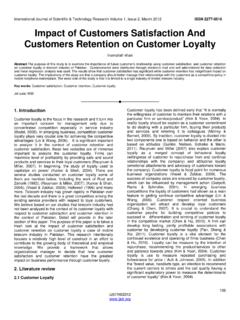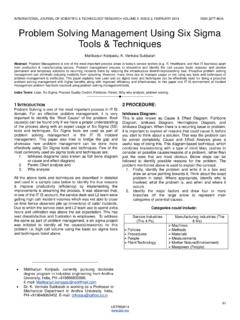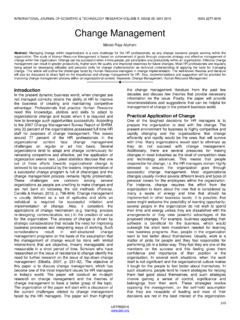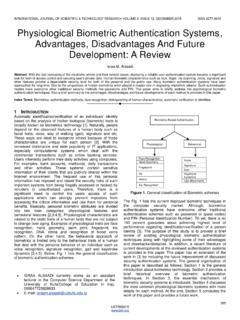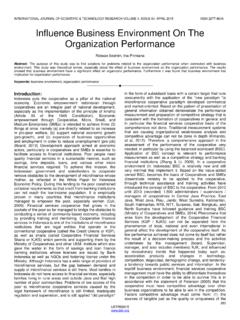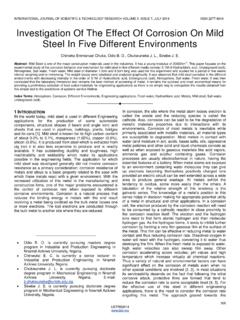Transcription of INTERNATIONAL JOURNAL OF SCIENTIFIC & …
1 INTERNATIONAL JOURNAL OF SCIENTIFIC & TECHNOLOGY RESEARCH VOLUME 5, ISSUE 05, MAY 2016 ISSN 2277-8616. Human Resource Predictive Analytics (HRPA). For HR Management In Organizations Sujeet N. Mishra, Dev Raghvendra Lama, Yogesh Pal Abstract: Human resource predictive analytics is an evolving application field of analytics for HRM purposes. The purpose of HRM is measuring employee performance and engagement, studying workforce collaboration patterns, analyzing employee churn and turnover and modelling employee lifetime value. The motive of applying HRPA is to optimize performances and produce better return on investment for organizations through decision making based on data collection, HR metrics and predictive models.
2 The paper is divided into three sections to understand the emergence of HR. predictive analytics for HRM. Firstly, the paper introduces the concept of HRPA. Secondly, the paper discusses three aspects of HRPA: (a) Need (b). Approach & Application (c) Impact. Lastly, the paper leads to the conclusion on HRPA. Index Terms: Predictive Analytics, Talent Analytics, HR Analytics, Human Resource Management, Modelling, Return on Investment (ROI), Decision Making, . 1 INTRODUCTION Predictive analytics is unlike descriptive analysis which HR analytics is a multidisciplinary approach to integrate considers external benchmarking data and involves tables, methodology for improving the quality of people-related reports, ratios, metrics, dashboards or complex maths; it is decisions in order to improve individual and organizational about data-derived insights that drive better decisions.
3 It performance. There are interchangeable terms used for HR includes statistical techniques, machine learning methods, and analytics are talent analytics, people analytics, and workforce data mining models that analyse and extract existing and analytics. HR analytics plays a role in every aspect of the HR historical facts to make predictions. It enables organizations to function, including recruiting, training and development, analyse the past and look forward to spot trends in key factors succession planning, retention, engagement, compensation, related to voluntary termination, absences and other sources and benefits. HR analytics are those that involve high-end of risk.
4 Predictive analytics involves models of organizational predictive modelling where what-if scenarios forecast the systems for prediction of future outcomes and realize the consequences of changing policies or conditions. Traditional significances of hypothetical changes in organizations. HR analytics focuses on the present, that is, items such as Predictive analytics have led to prescriptive analytics where turnover and cost per hire. But most organizations lacked a HR gets decision options to optimize performance and consistent and general view of the workforce and thus needed reshape entire HRM decision making. [6] Being an evolving HR analytics to perform workforce optimization and hence it phenomenon HRPA has much scope for HR purposes in became important for HR to develop IT and finance analytical future.
5 Predictive analytics might be unexplored zone for HR, skills and capabilities to produce better Return on Investment therefore to fully realize its profits; HR personnel need to team (ROI). [1], [2], [3] Further advancement of technologies when up with other business units and customer-facing functions to combined with predictive analytics exponentially enhanced HR understand how they pull data and analytics to create value. purposes in last decade. HRPA generates insights that cannot [7] HRPA faces constraints of training and resistant to adapt be achieved through traditional benchmarking as HR analytics from HR Personnel for a score of an employee is reactive and an evidence-based decision system whereas engagement survey may mean different things to different HRPA is proactive and fact-based decision system.
6 [4] Three lines of business, and regions around the world, depending on significant changes that have really created a hunger for business purposes, economic actualities and workforce size. predictive analytics in HR and these are: [5] Collin says, [8] HRPA is an art and a critical skill to bring out i. Major boost in computing power and its affordability the business insights of data analysis. There are opportunities ii. HR big data digitally accessible via cloud storage for for HRPA in HRM to expand due to necessary boost provided processing to enhance HR functions, to better business outcomes and to iii. Global talent war to protect and pursue talent improve ROI.
7 COO Vivek Madhukar indicated streams. to the fact that the ability to move from gut-based judgements to data-driven decision-making is making HRPA the future of HRM in India. Over 55 per cent of organizations feel that HRPA predictions help to secure quality hires. [9]. _____. 2 ASPECTS OF HRPA. Sujeet N. Mishra is currently pursuing master's degree program in computer science engineering in SRMU, India, Need PH-+918898181778. E-mail: Organizations make sure the right people are in the right place at the right time by means of analytics. [10] To remain Dev Raghvendra Lama is currently working as assistant commercially relevant HRM needs to provide senior professor in faculty of computer science engineering in executives with a predictive analytics based justification for SRMU, India.
8 E-mail: important talent related decisions. No organization is identical Yogesh Pal is currently pursuing master's degree program in terms of workforce, talent, environment, strategies, and in computer science engineering in SRMU, India, E-mail: market type. And hence one successful but fixed model cannot be applied to any function of HR. Only past data of the 33. IJSTR 2016. INTERNATIONAL JOURNAL OF SCIENTIFIC & TECHNOLOGY RESEARCH VOLUME 5, ISSUE 05, MAY 2016 ISSN 2277-8616. particular organization or its identical culture have ability to Predictive modelling [4], [15], [16] is applied on HR functions provide right decision for HRM. Thus HRPA becomes essential for decision making in various field of HRM as follows.
9 For industries which desire for bringing unique decision i. Turnover Modelling: Predicts future turnover of policies. The HR requires skills of technology and business in specific functions, business units, management both where technology is not limited to analytics. geographies and countries by looking at factors such HR should be able to create insights into data and produce as commute time, time since last role change, and predictive models that optimize the organizational performance over time. Thus this can scale hiring performance. Advent of advance machine learning programs efforts accordingly, reducing empty desk time and panic and HR expert systems [11] has eased to achieve hiring, which can lead to lower cost, higher quality organizational objectives of human capital management hiring.
10 (HCM), workforce planning, employee management, and ii. Response Modelling: Use old advertising jobs data performance management etc. from previous campaigns to avoid contacting candidates or using channels that don't yield a response and focus on those channels that do work. iii. Predictive Retention Modelling: Identify high-risk employees, build profiles, predict vacancies and leadership needs, and understand how risk is distributed throughout the organization. iv. Risk Modelling: Develop a profile of candidates with a higher risk of leaving prematurely or performing below standard. v. Talent Forecasting: Being able to predict which new hires, based on their profile, and are likely to be high fliers and then moving them in to your high potential programs.
